
|
||
|
Portland art blog + news + exhibition reviews + galleries + contemporary northwest art
|
||
Loss of Material Evidence at Hoffman Gallery  Mark Smith and Maria T.D. Inocencio at Lewis and Clark College (all photos Jeff Jahn) Arguably one of the strongest and easily the most intensive two person exhibition ever to be mounted in in Portland, Loss of Material Evidence by Mark R. Smith and Maria T.D. Inocencio at Lewis and Clark College's Hoffman Gallery, ends today. It also capstones its consummate curator's 20 year run in a blatant example of University administrative myopia and disregard for cultural offerings in higher education. First, let's concentrate on the exhibition as LoME is a tour de force in material as memory and pattern as personality translated via sustained activity/interaction with family members and other loved ones. This exhibition successfully goes into places where contemporary art often fails, specifically the persistence of personal familial affinity as a means of building meaning. It doesn't hurt that the two artists themselves constitute a family unit but I also appreciate how they both integrate and separate their individual voices. Perhaps, one can think of this as a memorable Thanksgiving dinner? For myself that what this constitutes, an extensive extended family feast... with all the simmering conflicts and savored time spent in reminiscence. All families, especially US families have to deal with the stuff the accumulate, but Mark and Maria made it into art and it cant help but be a gen X commentary. 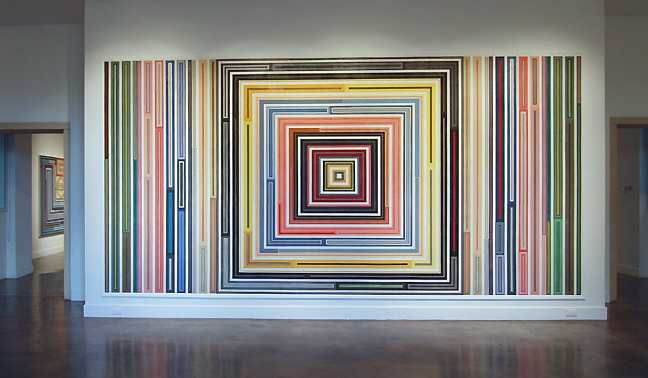 Time Tunnel Visitors are greeted by Time Tunnel, a large collaborative labyrinth wall piece by the two artists. Marriage is in itself a kind of time tunnel and each contributed in distinct ways. Maria apparently contributed the intensive structure while Mark's impressive eye for color, texture and pattern make visually absorbing. As someone who pays close attention to couples in the arts (being in a one myself) I cannot stress how rare a successful and integrated collaboration like this is. Sure, it might resemble high modernism but what it really constitutes is nonverbal monolith of what a close knit team can do. Perhaps only in Portland is the subject domestic machinations fetished and put on display like this exhibition and it is a major element of what Portland's art scene does better than any other in the USA. What Time Tunnel does well is introduce the viewer to the mesmerizing effect of material as a kind of token evidence of a life lived. Being constructed of fabrics that had previous uses it presents an engaging and partial picture... presenting the scope of the subject matter. In particular, that of families that accumulate stuff, which is then dealt with as they age and eventually pass on. I am generation X and have personally had to deal with much of this already. Do L&C students realize how important a subject this is? When I was in college I certainly could not have grasped it... but perhaps an art exhibition would have poetically made it more palpable. 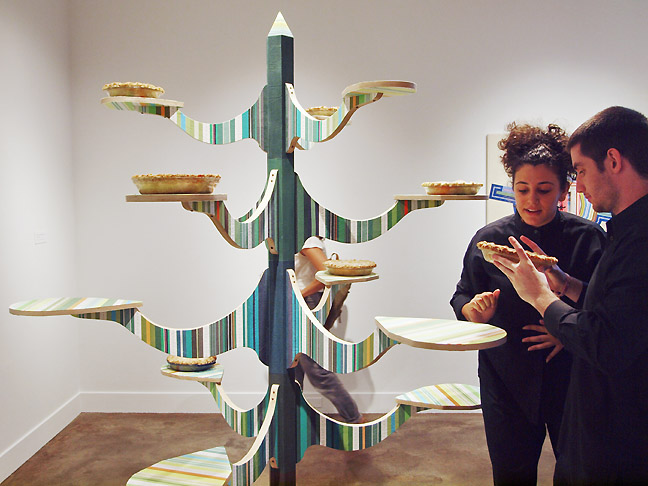 Perennial Host at opening A prime example of this familial sculpture is Perennial Host (another collaborative piece), which literally serves up apple pies to visitors, much like one of Mark and Maria's relatives at family gatherings. Many can related to this and I personally had an aunt ho produced award winning pies and passed on recipes to her children. With Perennial Host the Hoffman Gallery serves up a meal of materials and even served up fresh apple pies at the opening. That's pretty down home and an incredibly difficult thing to convey in contemporary art and the exhibition really becomes more expansive by turning the viewers into familial guests of sorts. 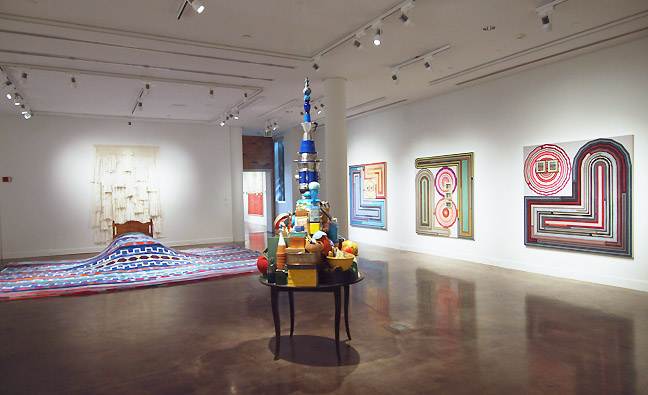 BG Heirloom Waterfall Maria T.D. Inocencio (heiloom baby clothes on wall), Receding View by Mark R. Smith and Maria T.D. Inocencio (Bed and quilt) etc.
BG Heirloom Waterfall Maria T.D. Inocencio (heiloom baby clothes on wall), Receding View by Mark R. Smith and Maria T.D. Inocencio (Bed and quilt) etc.
As the visitor moves into the largest gallery space a cascade of heirloom baby clothes cascades behind a small bed covered and given dramatic scale with a huge quilt of reclaimed textiles called Receding View. Its another collaborative piece and it gives a palpable sense of both being and loss. Is this a bed where children were conceived, raised and a sickbed where a love one spent hours holding court with loved ones? We can only imagine, and though I generally find "bed art" among the worst categories of contemporary art... this one really works. It provides literal scale and distance, it is poetic furniture and then some. 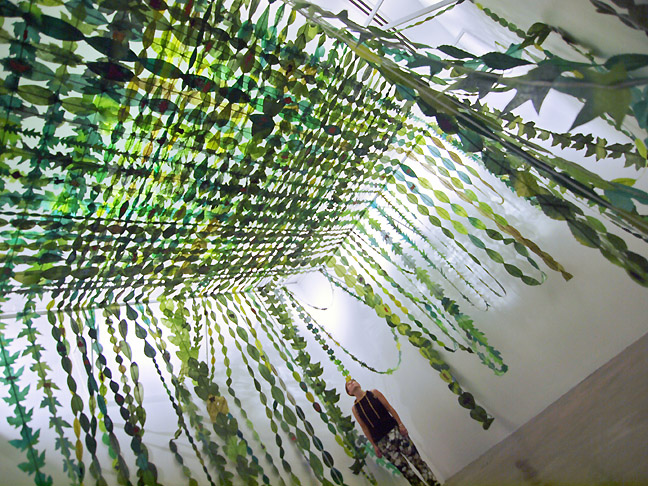 Comforter, Maria T.D. Inocencio 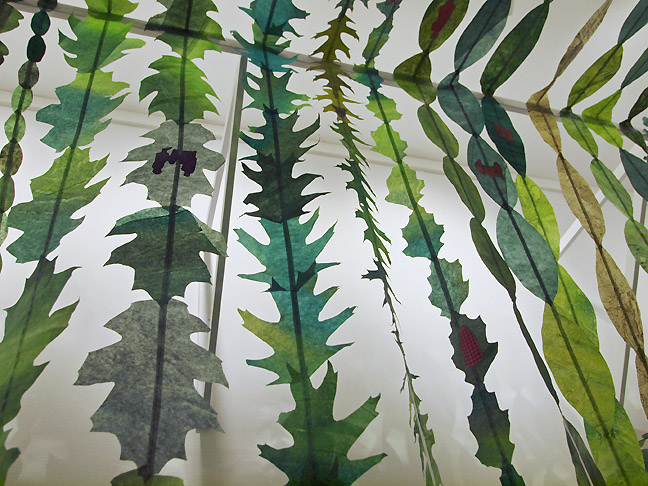
Comforter (detail) In a show full of stunners perhaps Comforter by Maria is the most memorable. An entire room constructed of leaves created one each day it obsessively maps the act of being the keeper of familial sentiment and persistence. Instead of a palimpsest it becomes a diary of material creation. Like a lot of Maria's work it is a catalog of days with leaves standing in as ephemeral signs of life. Notably they are all green... choosing to remember a Spring-like season rather than Fall's inevitable decay, it does give comfort, reminding me of why I like green so much as a color. The installation itself is easily the year's most memorable installation art piece in a year when everyone seems to need some comfort. 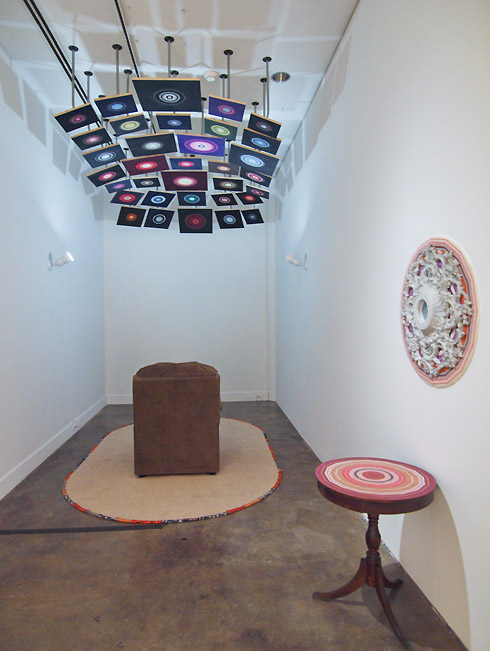 After Image: The Night's Sky and A Vision by Mark Smith There are so many other wonderful works like I Used to Think I Knew Everyone, A Vision and Waiting to Cry and but the other show stunner is Mark Smith's After Image: The Night's Sky. Its a touching recliner with a remote that brings the life of perhaps an old man to mind... a father, an uncle or grandfather. I know many who spent their last few years with limited mobility and a lot of time watching TV. But here it is a artists rendition of a night's sky. I its touching without being saccharine and somehow inspiring without evoking pity (not easy to do). The lozenge shaped rug recalls the pills that come with old age and its colorful reclaimed fabric edges are another of Mark's fantastic touches. 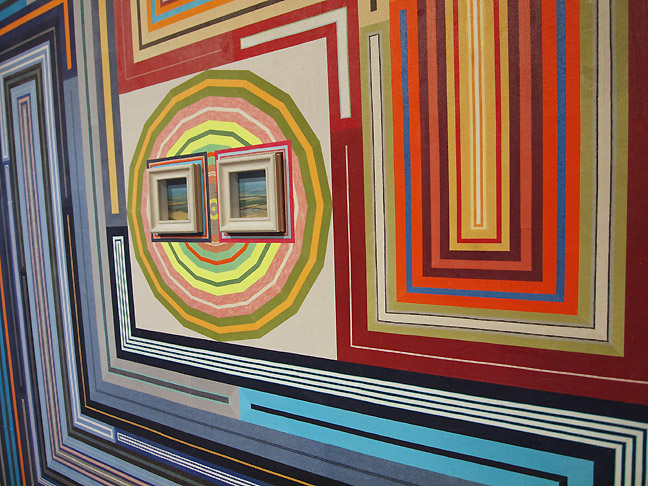 Mother: The Farthest 10 Acres (detail) The exhibition itself is a triumph of execution and scope, the sort of thing that simply cannot happen unless a curator with deep community connections, and eye and the will to plan years in advance can pull off. Portland is losing something at the Hoffman and it isnt just this excellent exhibition... its a the capability to mount anything similar in the future. Shame on you Lewis and Clark College... apparently higher education is not what it once was and at Lewis and Clark the ending of this exhibition makes the moment that loss occurred. The students of Lewis and Clark College and the Portland's civic fabric are the poorer for this colossal lack of vision. This is a show that traffics in material and memory and no none who has seen it is likely to forget it. 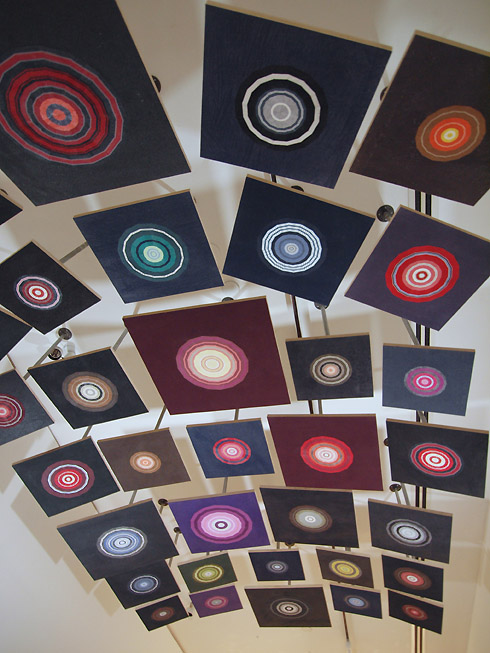
Loss of Material Evidence | September 8 - December 9 Hoffman Gallery Closing Reception: December 9 2-4PM Lewis and Clark College Posted by Jeff Jahn on December 09, 2018 at 10:05 | Comments (0) Comments Post a comment Thanks for signing in, . Now you can comment. (sign out)
(If you haven't left a comment here before, you may need to be approved by
the site owner before your comment will appear. Until then, it won't appear
on the entry. Thanks for waiting.)
|
| s p o n s o r s |
 |
 |
 |
 |
 |
 |
 |
 |
 |
 |
 |
 |
 |
 |
 |
 |
 |
 |

|
Site Design: Jennifer Armbrust | • | Site Development: Philippe Blanc & Katherine Bovee | |

